Six Sigma in Sports

Last Updated March 7, 2024
Six Sigma is a process improvement methodology that focuses on eliminating errors through reducing variability. The data-driven approach to quality improvement has been applied to a number of industries and processes over the years, but its usefulness in sports is relatively unknown.
However, just as Six Sigma can be implemented to improve efficiency and trim out unnecessary waste in industries such as healthcare and manufacturing, it can also be applied to an athlete or sports team seeking to maximize performance or find an optimal training regimen.
Six Sigma Fundamentals
If Six Sigma could be explained in one phase, it would be through the acronym DMAIC. DMAIC stands for Define, Measure, Analyze, Improve and Control, and it’s used to improve existing processes. The DMAIC methodology provides a type of roadmap which helps teams isolate problems, determine how to fix them, and then continuously improve processes to achieve effective and ultimately permanent solutions.
Front office staff, coaches and individual players are always looking for ways to improve overall team performance during the season. They are continually working to identify their weaknesses, reduce unforced errors and improve their own level of efficiency. While achieving Six Sigma – equal to 3.4 defects per million opportunities – is likely not feasible in most sports, the phases of the DMAIC methodology can be used to help identify, quantify and eliminate defects.
Here is how Six Sigma and DMAIC can be applied to sports:
- Define – The team clearly identifies what process they plan to analyze and specifies the roles of everyone involved in the assessment.
- Measure – The team begins to collect relevant data in order to help identify where variance is occurring. In the Six Sigma methodology, variance is considered the root of the efficiency problem.
- Analyze – The team takes the data gathered in the previous step and starts to break it down to pinpoint areas for improvement. Any problems are quantified and isolated so that they can be addressed in subsequent stages.
- Improve – The team takes the root cause of the issue and brainstorms to find a solution to the problem. This step may take some trial and error, but ultimately, its goal is to make the entire process more effective.
- Control – The team documents the new solution and passes it on to relevant stakeholders. Improvements are implemented and, after a trial period, assessed to determine whether they’ve improved performance at expected levels.
Examples of DMAIC in Sports
In sports, Six Sigma concepts can be used to isolate the weakest link in athletic performance and improve it. In an individual sport like golf, for example, a golfer might use DMAIC to analyze performance with specific clubs and determine areas of play that require more practice. By using quantified data at various points on the course, the golfer can identify problem areas and then spend time specifically on them to improve overall performance.
Using DMAIC with team sports presents a different array of challenges, as it becomes more difficult to pinpoint problem areas when working with a wider range of variables because of the interaction of multiple athletes. Even so, it is possible. Consider a football coach who chooses to focus on a specific player, such as the quarterback, and analyze this athlete’s performance extensively. While it may be harder to assess the entire team with DMAIC, it can be done if the team is understood to be a collection of individual athletes who each contribute to overall team performance.
Using Six Sigma in sports is not necessarily about achieving “perfection” as it is sometimes understood in the business context, where the goal is absolutely minimal variation in performance. Yet, it is about maximizing an individual athlete’s performance by isolating, addressing and then fixing key problem areas. By taking these small, focused steps, athletes can reduce their errors and incrementally reach their highest potential.




